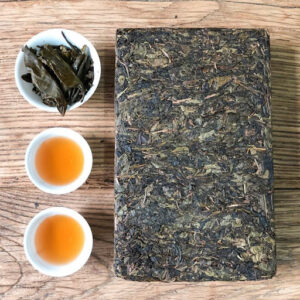Pu’er tea, also known as pu-erh tea, is a variety of fermented tea traditionally made from large-leaf varietal of Camellia Sinensis var. assamica in Yunnan Province, China. Unlike other kinds of teas (including green tea, white tea, oolong tea and black tea) that are classified by the percentage of oxidation and resulted from chemical enzymatic reactions, pu’er tea has a special process of fermentation, which is a microbial activity occurs with or without oxygen present. Based on the different processes of fermentation, pu’er tea is divided into two types: raw pu’er (sheng) and ripe pu’er (shou). Like Champagne or other regionally specific foods and beverages, pu’er tea is a geographically indicated product. This tea can only be produced and fermented in southern Yunnan Province using sun-dried green tea from specific tea varieties found in Yunnan, Laos, Burma and some parts of Thailand and Vietnam.

What is raw pu’er (sheng)?
Raw pu’er tea, pronounced as sheng pu in Chinese, is a traditional kind of pu’er tea that fermented naturally over a long period. Raw tea is made from the fresh leaves of Yunnan large-leaf varietal tea tree, and the material is called rough tea (mao cha). Rough tea, referring to an unfinished stage that is withered and partially roasted, can be sold in original form directly or pressed into different shapes such as cake, brick and tuo, and is called raw tea or uncooked tea. Though the early processing is similar to that of green tea, raw pu’er tea is designed for aging, thus the tea’s initial flavor is usually bold, astringent, and often bitter. Over time, just like the ripening of cheese or fermentation of wine, raw pu’er tea can mellow into a dark smooth mouthfeel, and raw teas that have been stored and aged for at least 10 years are considered “drinkable” by connoisseurs.

Raw pu’er tea is usually dark green in appearance, pure and long-lasting for aroma, and the tea soup can change from light yellow to yellow-green and then to orange yellow. The longer the storage time of raw tea, the more mellow and more variable of the fragrance. The natural aging process of raw pu’er tea was discovered by accident, when Ancient Tea Horse Road was a network of caravan paths winding through the mountains of Sichuan, Yunnan and Tibet in Southwest China dating back to over 1,000 years ago. With several months of transportation, packed pu’er teas on the horsebacks were aged by the temperature and humidity of the climate, and also changed color and flavor when arrived at the destination. As a result, the natural and traditional way of aging tea is inherited for raw pu’er tea. When it comes to the 20th century, demand for pu’er teas began to outpace the supply from traditional aging processes, especially in Hong Kong and many Asian areas. To keep up the demand, a technique to accelerate fermentation and imitate aged raw teas was developed in 1973, thus ripe pu’er tea is created.
What is ripe pu’er tea (shou)?
Ripe pu’er tea, pronounced as shou in Chinese, is deemed as a cooked tea. Ripe tea is made from the same rough tea leaf as raw tea, but uses a special technique called wet piling (wo dui) to imitate the effects of long-term aging with an accelerated process of fermentation. To make ripe pu’er tea, the green rough tea is withered and slightly roasted. Next, tea workers heap the rough tea into a large high pile (usually 70 cm high), spray some water to the pile, and cover the pile with linen and leave the tea leaves to ferment. The wet piling technique is kept confidential by the tea factories, since it’s the key to the success of the ripe pu’er tea. Some tea makers will mix in a small amount of a previous batch of tea to introduce desirable microbes when piling.

During the process, the dense pile produce heat that encourages fermentation, the microbial activity. The leaves are turned regularly to control the temperature and humidity. Usually after a period around 1 to 2 months, when fully fermented, the tea leaves can be stored as loose form or pressed into different shapes, and the ripe pu’er tea is made. The first ripe pu’er tea came on the market in 1975. Though aging is also important for ripe teas, the taste of ripe pu’er tea will not change as much as raw pu’er teas over time.
Why pu’er tea is worth drinking?
- Many health benefits
Pu’er tea may promote weight loss by helping synthesize fewer new fats while burning more stored body fat , and introducing healthy probiotics that improve the blood sugar control; pu’er tea may help in reducing cholesterol levels, inhibiting cancer growth, boosting liver, skin and cognitive health, aiding digestion, and improving cardiovascular wellness.
- Unique flavor changed by age
Over time, the fermentation process fundamentally changes the molecular compounds within the tea leaf, transforming the flavor profile into something unique. Though considered to be “earthy”, pu’er tea’s flavor variation can be woody mushroom, sweet hay, or herbal flavor notes like camphor and aloe. The potential for vast flavor variety of pu’er tea makes it an interesting adventure for palate.

- Easy to brew without bitterness
For pu’er tea, the process of fermentation breaks down naturally bitter compounds within the leaf, which is called “tannins”. Tannins in tea will lead to bitterness and astringency, however, as time goes by, tannins soften and fade over time in these teas, leaving flavor that is bold and no bitterness, just like well-aged wines. Also, the aging process that naturally creates raw teas breaks down caffeine over time, thus raw teas contain less caffeine than ripe teas.
- Pair with different food
Pu’er tea is the perfect accompaniment to a hearty dinner or rich dessert, with bold flavors that pair perfectly, and microbial activity that helps the body digest heavy fats. The strong, smooth profile of pu-erh is a perfect complement to heavy foods.
How to store pu’er tea?
Both raw and ripe of pu’er teas can be stored for long periods of time. As long as the storage is proper and the environment is suitable, the longer the storage, the better the flavor. Pu’er teas are better to store in unglazed clay containers, such as Yixing clay, since they are breathable and can reserve the tea well. If such clays are not available, a sealed cardboard box or even a clean paper bag is fine for pu’er tea, on condition that these materials have no chemical odours.

The best location for storaging tea is a cool dry place, away from big temperature fluctuations and odours, since tea is polyporous and may absorb odours from the environment. For the tea that intends to be stored for long term, it’s better to keep it in the original paper packaging. For the tea that is to be consumed, use a tea knife to break and pick up the tea of small pieces for each use. Since more of the surface of the tea is now exposed to air, oxidation will develop the complexity of tea more rapidly.
How to brew pu’er tea from compressed form
If you’re making pu’er tea from a compressed form (e.g. cake, brick or tuo), you’ll need to gently pry off about a teaspoon or two of leaves. You can use a tea knife, or a small dull knife to do this.

Once you have your pu’er tea leaves ready to steep, you need to rinse them first, especially if the pu’er is raw rather than ripe. The rinsing is intended to remove dust formed as the pu’er has fermented, as well as to awaken the compacted tea leaves (prepare them ready for infusion). To rinse your pu’er, place the tea leaves in a brewing vessel (Gaiwan or teapot), pour near-boiling water over them and then quickly discard the water.
After you’ve rinsed the pu’er, you’re ready to steep it. Use boiling water and steep for 1 to 2 minutes (if using a Yixing teapot or Gaiwan) or 3 to 5 minutes (if using Western teaware). High-quality pu’er tea can be brewed for at least 8 times.






WOW just what I was searching for. Came here by searching for decorative